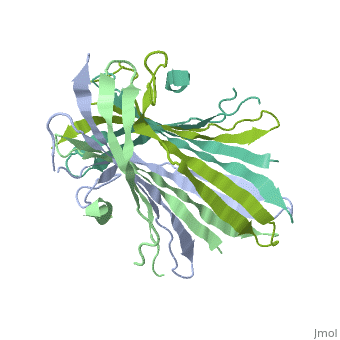This is a default text for your page Vinícius M. Neto/Sandbox 1. Click above on edit this page to modify. Be careful with the < and > signs.
You may include any references to papers as in: the use of JSmol in Proteopedia [1] or to the article describing Jmol [2] to the rescue.
Function
Basic structure
The N-Terminal domain of the fibroin heavy chain (FibNT 3UA0) is a homo 4-mer composed of 268 residues, being most of them (hidrophilic amino acids in marron and hidrophobic in medium blue). FibNTs is a homodimer with 8 alternated β-sheets and a disordered C-terminus portion (Gly109-Ser126). Its two chains (chain A and chain B) are roughly the same but for the N-terminal segments (Phe26-Val35), that form a short helix packing in the chain A and a loop in the B.
The FibNT homodimer has the following topology: β1A–β2A–β4B–β3B–β3A–β4A–β2B–β1B. The β-sheets are conected with 2 β-hairpins (Thr36-Asn65 and Glu78-Ser107) and 2 type1 β-turns (Asp49-Gly52 and Asp89-Gly92). The whole assembly is packed toghether with several hidrogen bonds between the β-sheets.
Oligomerization
Fibroin oligomerization is deeply afected by the pH. Naturaly, during the silk spinning process, the fiber is subjected to a decreasing pH gradient from the anterior to the posterior part of the silk gland, which triggers the gelation of the condensed fibroin. In particular, the FibNT exists in a random coil state, which prevents premature formation of β-sheets. As the pH decreases to around 6.0, FibNT undergoes a structural transition to form β-sheets.
Relevance
Structural highlights
This is a sample scene created with SAT to by Group, and another to make of the protein. You can make your own scenes on SAT starting from scratch or loading and editing one of these sample scenes.

